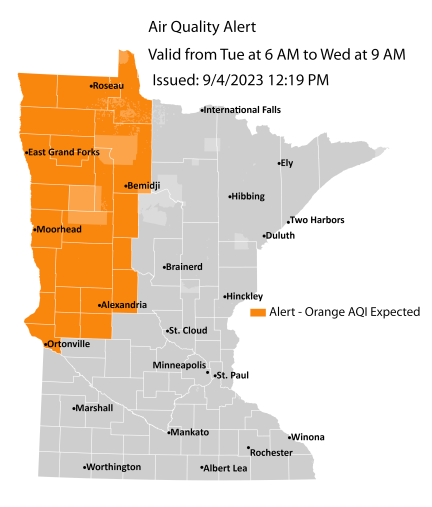
Air quality in northwest Minnesota is expected to reach the orange AQI category, which is unhealthy for sensitive groups.
The Minnesota Pollution Control Agency (MPCA) has issued an air quality alert for northwest Minnesota. The alert takes effect at 6 a.m. on Tuesday, Sept. 5 and runs until
A strong low pressure system will move across central Minnesota on Tuesday. Strong northerly winds behind the system will pull Canadian wildfire smoke into Minnesota. The smoke will reach the state by 6 a.m. Tuesday and will impact northwest Minnesota through the end of the day. The frontal boundary over the state will keep smoke limited to this area for much of the day. As the system moves east, smoke is expected to reach southwest Minnesota around 4 p.m. Tuesday. Winds will become westerly, and smoke may progress eastward across southern Minnesota overnight. Smoke may also move into northeast Minnesota Tuesday evening as well. The alert will be expanded as needed on Tuesday. Northwest winds will continue on Wednesday and smoke will begin to clear the state. Air quality will first improve over northern Minnesota Wednesday morning. Air quality will improve Wednesday afternoon across southern Minnesota.
Fine particle levels are expected to reach the orange air quality index (AQI) category, a level considered unhealthy for sensitive groups, across northwest Minnesota. This area includes Alexandria, Ortonville, Bemidji, East Grand Forks, Moorhead, Roseau, and the tribal nations of Leech Lake and Red Lake. In the orange area, sensitive groups should limit prolonged or heavy exertion and time spent outdoors.